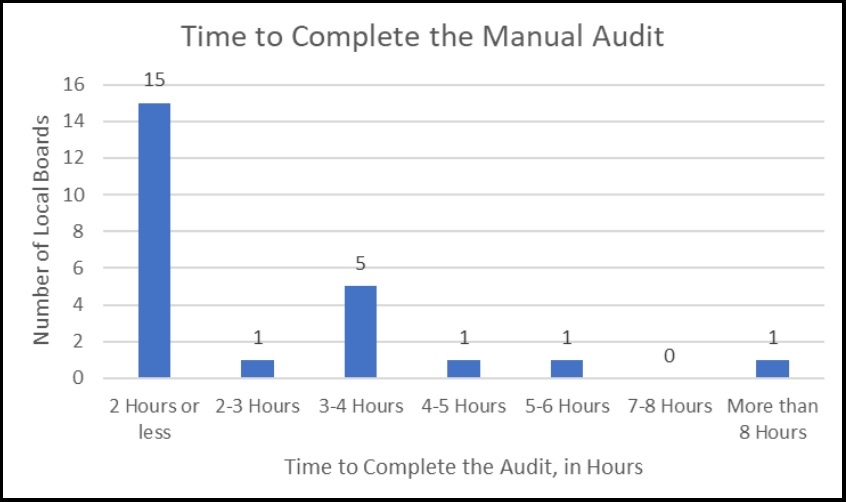2022 General Election: Post-Election Manual Ballot Tabulation Audit
The post-election manual ballot tabulation audit requires an audit of:
1) At least 2% of election day precincts, including at least 1 randomly selected election day vote center in each county and the remainder of election day vote centers to be chosen by SBE; and
2) A number of votes equal to at least 1% of the statewide total in the previous comparable general election[1] of ballots cast during early voting and mail-in and provisional ballots, including a minimum number in each county, as set by SBE. For the 2022 General Election, SBE has set 15 votes as the minimum number of mail-in ballots and provisional ballots for each county.
The manual audit must be completed by each local board within 120 days after the general election. If the manual audit shows a discrepancy greater than 0.5%, SBE can expand the manual audit and take any other actions it considers necessary to resolve the discrepancy.
[1] "Previous comparable general election" is defined as (1) in a presidential election year, the presidential election held four years earlier and (2) in a gubernatorial election year, the gubernatorial election held four years earlier. For the 2022 General Election, the previous comparable general election held was the 2018 General Election.
Selecting the Contest to be Audited
In 2018[2], for the inaugural manual audit, the State Board set the following parameters for the contest to be audited. Those parameters are:
- That the same contest be audited by each local board of elections. Therefore, the contest to be audited shall be a statewide race.
- That the contest would be a "pick one" contest.
Using these same parameters, the eligible contests for the 2022 General Election were Governor/ Lt. Governor, Comptroller, Attorney General, or U.S. Senate. SBE used a random number generator to determine the contest to be audited. Governor/Lt. Governor was selected.
[2] Full minutes of the November 29, 2018 State Board of Elections meeting, when the Board decided the parameters for the contest to be audited, can be found here (PDF).
Selecting the Number of Ballots to be Audited
Before the election, SBE determined the number of ballots to be audited in each local jurisdiction for ballots cast during early voting and mail-in and provisional ballots, as well as the ballots from election day precincts to be audited. This chart shows the minimum number of ballots (PDF) from each jurisdiction to be audited based on the requirements set forth in §11-309 of the Election Law Article, and this chart shows which election day precincts were selected for audit. (PDF)
Mail-in and Provisional Ballots
The number of mail-in and provisional ballots in the audit is based on the turnout from the 2018 General Election (PDF). The number of mail-in ballots and provisional ballots to be audited was calculated by multiplying the 2018 relevant turnout by 0.01, in order to determine 1% of the total number of ballots cast in each category. If 1% of the 2018 turnout was less than 15 ballots, the local board audited 15 ballots.
Each local board selected the mail-in and provisional ballots to be audited, as they prepared for the respective canvasses. These ballots were then kept separate from the remainder of the mail-in and provisional ballots and mark them as "audit ballots."
At the start of the first mail-in and provisional canvasses, these ballots were presented, reviewed, and tabulated first, and then stored in sealable boxes marked "Mail-in Ballots for Manual Audit" or "Provisional Ballots for Manual Audit." At the completion of each canvass, the sealed boxes containing the ballots to be audited were stored with the remainder of the mail-in or provisional ballots.
Early Voting Ballots
The formula used to determine the number of mail-in and provisional ballots to be audited is also applied to early voting. Using the early voting turnout from the 2018 General Election (PDF), 1% of that turnout was calculated to determine the number of early voting ballots for each local jurisdiction to be audited.
Jurisdictions with only one early voting center audited ballots from that early voting center. For jurisdictions with more than one early voting center, SBE used a random number generator to select the early voting center to be audited. Local boards were notified of the selected early voting centers the day prior to the first day of early voting. A list of the selected early voting centers can be found here (PDF).
By 7 pm on the first day of early voting, the chief judges at the selected early voting centers determined which scanner met the minimum number of ballots to be audited. If none of the scanning units met the minimum, two scanners were selected. At the close of the first day of early voting, and after all voters have left the building, a local election official ran a results report from the selected scanner(s). The election officials secured the ballots from the selected scanner(s) and the report(s) in a sealed box.
Election Day Ballots
Section 11-309 of the Election Law Article requires that 2% of all statewide precincts must be audited, including at least one precinct from each local jurisdiction. For the 2022 General Election, there were 2074 election day precincts, of which 2% equals 41.48, which was rounded up to 42.
To select the required election day precinct from each local jurisdiction, a random number generator was used in the same manner that the early voting centers were selected to select the election day precincts. After the minimum of one precinct from each local jurisdiction was selected, the remaining 18 precincts were selected from all 24 jurisdictions.
Local boards were notified of the election day precincts that day. This chart shows which precincts were selected for audit. (PDF)
Preparing for the Audit
Each local board spent approximately a half day (4 hours) to two days (16 hours) preparing for the manual audit. This is similar to the amount of time required to prepare for the manual audit in past elections. Smaller local boards generally used all or most staff in audit preparations, while larger local boards used five to ten individuals.
Preparation tasks include sorting the ballots into batches, preparing batch tally sheets for each batch, selecting audit tallying teams, setting up the audit room, and preparing audio & video equipment if the audit will be live streamed. Additionally, all local boards are required to public notice of the audit, which must be mailed or emailed to candidates for the contest to be audited, as well as posted on the local board's website and in the front of the office ten days prior to the audit.
Conducting the Audit
Each local board conducted a manual audit of the required ballots within 120 days of the 2022 General Election, starting with Harford County on January 9, 2023, and concluding with Prince George's County on February 27, 2023.
Time to complete the audit: A survey of local boards revealed that the time to complete the manual audit ranged from less than two hours to more than 8 hours days. More than half of the local boards completed the manual audit in less than two hours. This is similar to the amount of time required to conduct the manual audit in past elections. The chart below breaks down the time needed for each local board to complete the manual audit.

One local board, the Prince George’s County Board of Elections, required two days to complete the audit. Initially, there was a discrepancy between the audit results and results from the voting system and certain ballots needed to be retabulated. In the end, the Prince George’s County Board of Elections reconciled the discrepancy.
Number of individuals involved in the audit: The most common number of audit tallying teams was four, which seven local boards needed to complete the audit. Ten local boards used between five and eleven audit tallying teams, while the remaining local boards required only two to three audit tallying teams. Each audit tallying team is composed of two individuals, but one local board, the Baltimore County Board of Elections, used three-person tallying teams. The total number of individuals required to complete the audit, including the audit tallying teams and any other required staff members, ranged from six to 35 individuals. As expected, larger local boards required more individuals to complete the audit.
Results of the Audit
This chart (pdf (PDF), xlsx (XLS)) shows the numerical results of the post-election manual tabulation audit. As the chart shows, there were no vote differences between the manual audit and the voting system results in 22 of the 24 local jurisdictions. Two discrepancies in one local board were determined to be human error during the initial mail-in and provisional canvass, and the other discrepancy was due to an overvote that the audit team did not see. Overall, 44,139 ballots from all 24 local jurisdictions were audited, resulting in a statewide audit contest vote discrepancy of 0.009%. Total, there were 2,005,223 ballots cast for Governor, which resulted in a statewide contest vote discrepancy of 0.00019%.
Anne Arundel County
In the audit of election day ballots, there was a one vote difference in the votes for the Cox/Schifanelli ticket, and a one vote difference in overvotes. The voting system reported 1,409 votes for the Cox/Schifanelli ticket, while the audit reported 1,410 votes. For the overvotes, the voting system reported four, while the audit reported three overvotes.
After reviewing the ballots, the local board found one ballot with a single, very small dot in the bubble for the Harding/White ticket and a fully completed bubble for the Cox/Schifanelli ticket. The voting system counted this ballot as an overvote, while the auditors did not count it as an overvote and instead determined it was a vote for the Cox/Schifanelli ticket.
Cecil County
In the audit of mail-in ballots, there was a one vote difference in the votes cast for the Co x/Schifanelli ticket. The voting system reported 44 votes for this ticket, and the manual audit identified 43 votes for this ticket. In the audit of provisional ballots, there was also a one vote difference in votes cast for the Moore /Miller ticket. The voting system reported 265 votes, while the manual audit revealed 264.
While attempting to reconcile the discrepancy, the local board determined that in both instances the ballot returned by the voter had been duplicated during the canvass and both ballots – the one returned by the voter and the duplicated ballot – were counted. This explains how the voting system counted two more ballots than the manual audit.
There were 1,950 ballots counted in Cecil County's audit and resulted in a difference or "total vote discrepancy" of 0.103%, which is well below the 0.5% threshold to trigger additional auditing. If the ballots returned by the voters had not been scanned into the voting system, there would not be a discrepancy.
These audits showed that the voting system accurately counted 44,141 votes cast for Governor and Lt. Governor. Another audit – the automated ballot tabulation audit – confirmed that the voting system accurately counted over 2 million ballots in the 2022 General Election.
2020 General Election
Click here to see the report and results of the 2020 Post Election Manual Ballot Tabulation Audit.

 MSBE
MSBE